Southernmost Telescope Gets an Array of UpgradesThe Keck Array is Done. Long Live the BICEP Array.Posted October 12, 2020
One of the telescopes at the bottom of the world is getting a major upgrade. 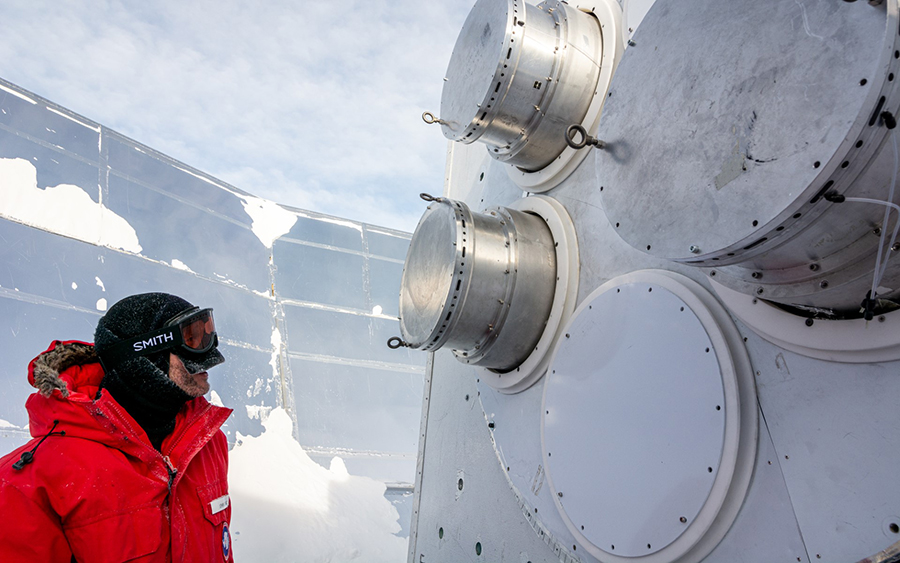
Photo Credit: Mike Lucibella
Principal investigator John Kovac takes a look at the Keck Array as it's being disassembled to make way for the BICEP array.
The South Pole's venerable Keck Array is being reconstituted into the more powerful BICEP Array, making it more sensitive and better able to observe the most ancient light in the universe. The Keck Array's five telescope tubes, known as receivers, are being replaced by four larger receivers containing an order of magnitude more light detectors. "To achieve even greater sensitivity, we took these small telescopes and we grew them just a little bigger," said John Kovac of the Harvard-Smithsonian Center for Astrophysics and principal investigator. "They're capable of each collecting ten times as many photons, and holding ten times as many detectors. So their sensitivity has grown by that much per telescope tube." The team hopes that with all of these receivers working together, the telescope can resolve some of the oldest light in the universe in more detail than ever before, to answer one of the persisting cosmic questions leftover from when the universe was less than a second old. The research is supported by the National Science Foundation, which manages the U.S. Antarctic Program. 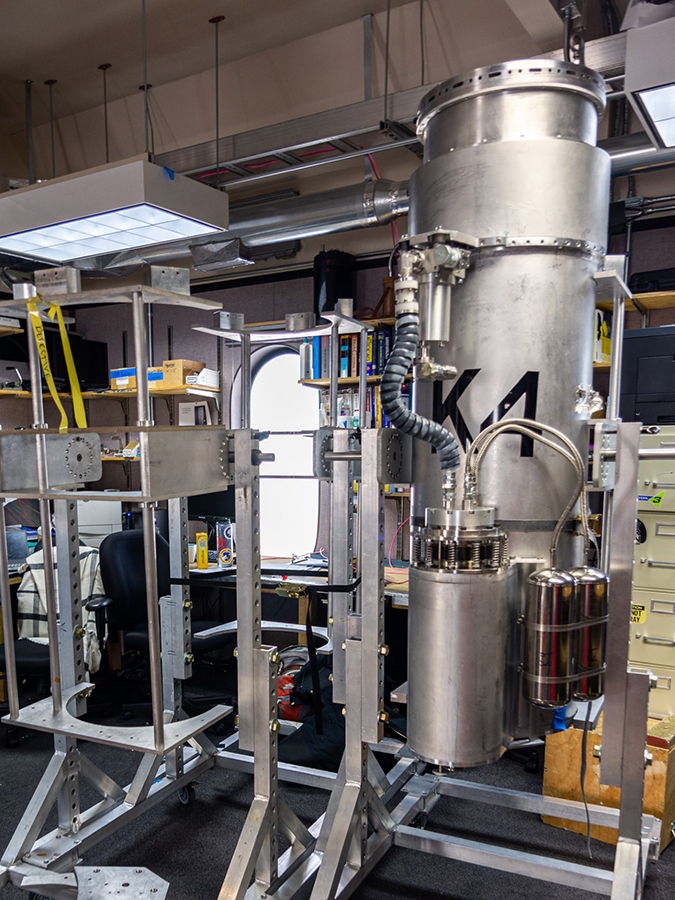
Photo Credit: Mike Lucibella
One of the receivers extracted from the Keck Array as it awaits further disassembly in the MAPO laboratory.
Ancient Light"The BICEP series of telescopes are telescopes that observe the oldest light in the universe, the cosmic microwave background," Kovac said. "We're using the light that comes from when the universe was in a hot dense early state to study the universe at even earlier times." The team is looking for evidence of "inflation," a moment just a fraction of a second after the Big Bang when the universe expanded dramatically in size because of quantum mechanical forces. They think its swirly polarized signature is embedded in the oldest observable light in the universe, the Cosmic Microwave Background, emitted when the universe was only about 380,000 years old. The CMB is visible in every direction of the universe as a dim glow that emits faint microwaves. By training their telescopes on a single area of the sky for years, the team will be able to collect vast amounts of data on the CMB and map its polarization to find the tell-tale signs of inflation embedded within. "These telescopes are challenging our ideas of how the universe itself began, by probing specific theories of the initial conditions of the Big Bang," Kovac said. "What's exciting to me is that on timescales of the careers of the graduate students that are building these telescopes right now, we can hope to answer questions about theories of how the Big Bang started [and] what are the physics that drove the origin of our universe." 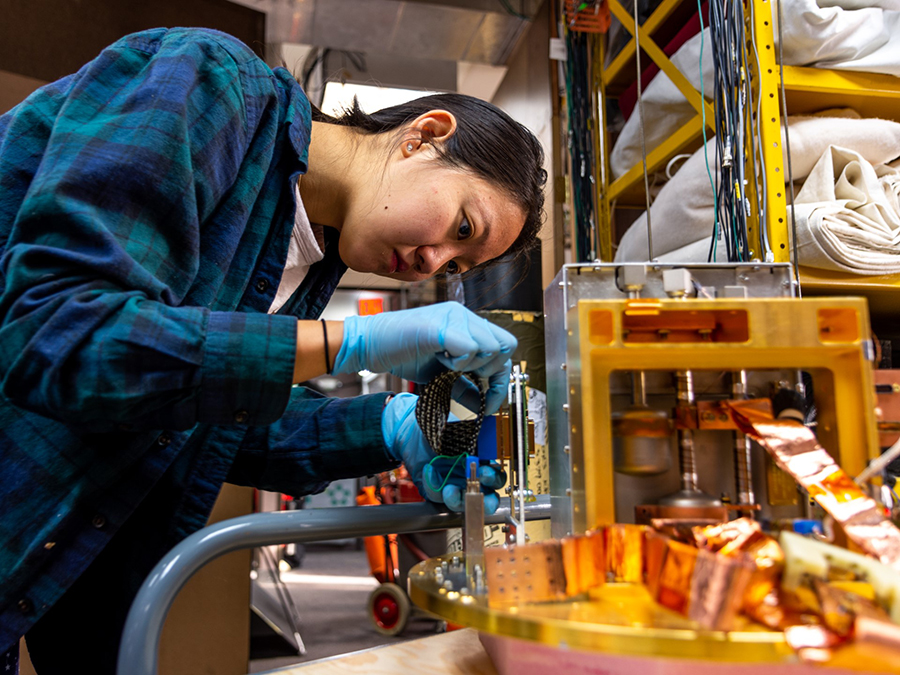
Photo Credit: Mike Lucibella
Cyndia Yu works on disassembling one of the receivers of the Keck Array.
Though inhospitable, the South Pole is one of the best places on Earth to build telescopes that can see the CMB in fine detail. Water vapor in the air ordinarily absorbs the microwave frequencies the teams are looking for, clouding out what they're trying to see. The South Pole is in the middle of the driest desert on the planet, and at more than 9,000 feet of elevation, the air is so thin it makes for pristine observing conditions. Even so, it's a difficult measurement to make because the readings have to be so precise. Different generations of telescopes have been studying the cosmic microwave background from the South Pole for about 25 years. Every few years the equipment gets an upgrade as the technology improves. "It actually turns out the most effective strategy for these kinds of science questions to be able to continuously build more and more powerful telescopes," Kovac said. "We can achieve higher sensitivity than you can by spending a decade building a telescope and launching it out into space for much more money. The reason is because the technology advances so quickly in this field." Keck to BICEP
Photo Credit: Mike Lucibella
The focal plane from one of the Keck Array's receivers, which acts as a camera image's sensor. The BICEP Array will upgrade the number of detectors, akin to pixels, on its focal plane by about a factor of 10.
The team operates two telescopes. The first is the third-generation of the Background Imaging of Cosmic Extragalactic Polarization telescope, better known simply as BICEP3, which is a single powerful receiver. The other is the former as the Keck Array, named on behalf of the W. M. Keck Foundation. It features five smaller, less powerful receivers joined together, and is in the process of being upgraded to the full BICEP Array. BICEP3, the upgrade to the previous BICEP2, was installed at the South Pole in late 2014 and has been scanning the skies ever since. Now, the team is taking that BICEP3 telescope, making four more copies of it, and mounting them together to all look at the same spot in the sky. The upgraded optics in the telescope will give them much more detailed pictures of the cosmos. With multiple receivers, they can each observe a different frequency, or "color," of microwave light. This way, they can better pick out the signal from the primordial universe they're looking for from the rest of the background noise. "We separate those signals from the primordial signals according to the ‘color' of the light," Kovac said. "By measuring light at many different frequencies, we're able to separate out the components that come from galactic synchrotron radio emission, galactic dust, and other kinds of astrophysical emissions that also enter our data sets in addition to the primordial signals that we're primarily interested in studying." 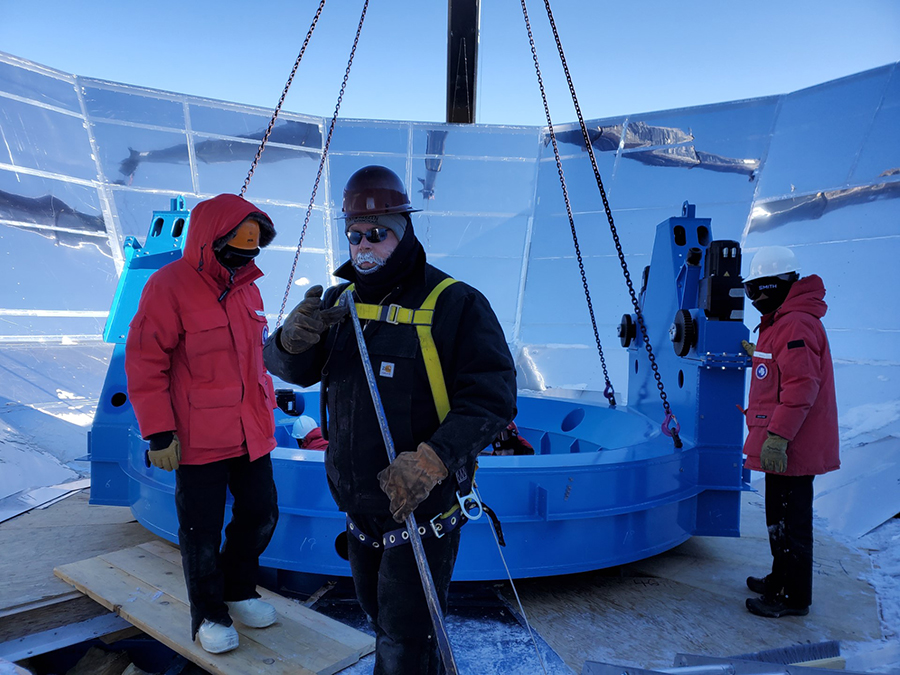
Photo Credit: Becky Gutknecht
(Left to right) Nathan Precup, Erik Nichols and Kenny Lau oversee the installation of the new telescope mount for the BICEP Array on the MAPO building.
Two of the receivers will be tuned to the frequency the CMB emits the strongest light, while the others will collect data from the dust and other noise to help subtract that out from the signal. They've done this type of upgrade before. "Similar to how the Keck Array was multiple copies of BICEP2, the new BICEP Array telescope will be multiple copies of BICEP3-like optical systems," Kovac said. The new technology going into the BICEP array will mean a big increase in sensitivity and resolution. The former Keck array contained all together about 1,800 detectors, akin to pixels on a digital camera sensor, whereas the completed BICEP Array will contain nearly 33,000. Though similar in ways to a camera sensor, they're specially engineered to detect signals that no commercial camera would be able to image. "The detectors are kept at a small fraction of a degree above absolute zero so that they are sensitive to some of the faintest signals that are observable in the universe," Kovac said. 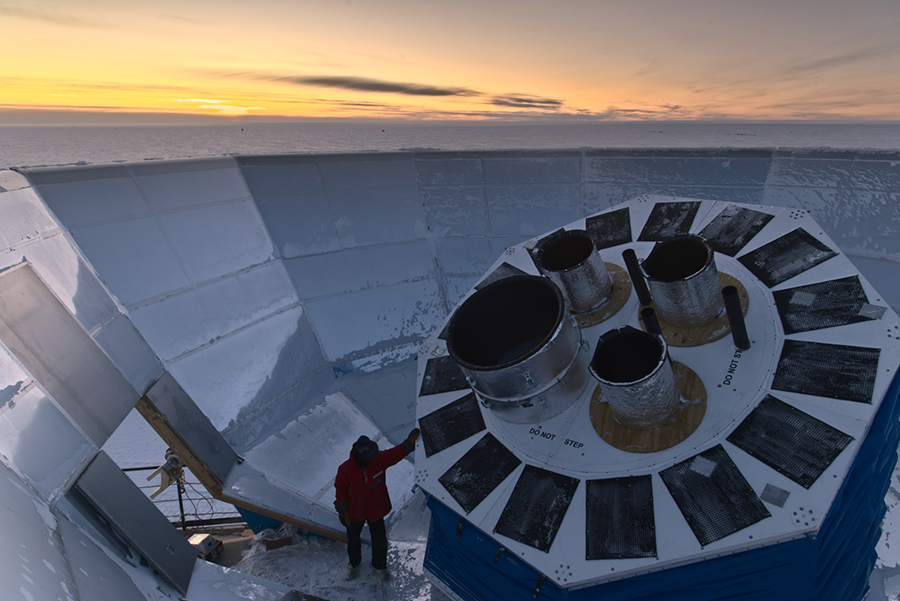
Photo Credit: Nathan Precup
Wintering scientist Nathan Precup stands next to the reconstituted BICEP Array. The large cylindrical receiver is the first of the BICEP3-style receivers installed, while the other three smaller receivers are repurposed from the former Keck Array until the more powerful BICEP3 receivers replace them in future seasons.
The increased size of the new receivers means that in addition to just upgrading the telescopes themselves, the mounts holding them had to be replaced as well. Over the austral summer, the team first carefully disassembled the Keck Array down to its base. With the help of the support staff at the station, they then removed the mount itself, the first time since the construction of the observatory that the entire mount had been removed. Once the new mount was swapped in, the team fitted installed the first of the new BICEP receivers onto it. Three of the older Keck receivers were also installed back onto the mount as well. The plan is to continue to use the Keck array receivers until the newer, more powerful BICEP receivers are completed and installed in future seasons. "Operations are going to be continuous as we are replacing the Keck Array receivers with BICEP Array receivers. We're going to be going deeper and deeper every year," Kovac said. This past austral winter, the array took its initial round of calibration observations, and the team is looking forward to starting full-scale science operations soon. NSF-funded research in this story: John Kovac, Harvard University, Award No. 1638957. Chao-Lin Kuo, Stanford University, Award No. 1836010. James Bock, California Institute of Technology, Award No. 1313062. |
"News about the USAP, the Ice, and the People"



For USAP Participants |
For The Public |
For Researchers and EducatorsContact UsU.S. National Science FoundationOffice of Polar Programs Geosciences Directorate 2415 Eisenhower Avenue, Suite W7100 Alexandria, VA 22314 Sign up for the NSF Office of Polar Programs newsletter and events. Feedback Form |


